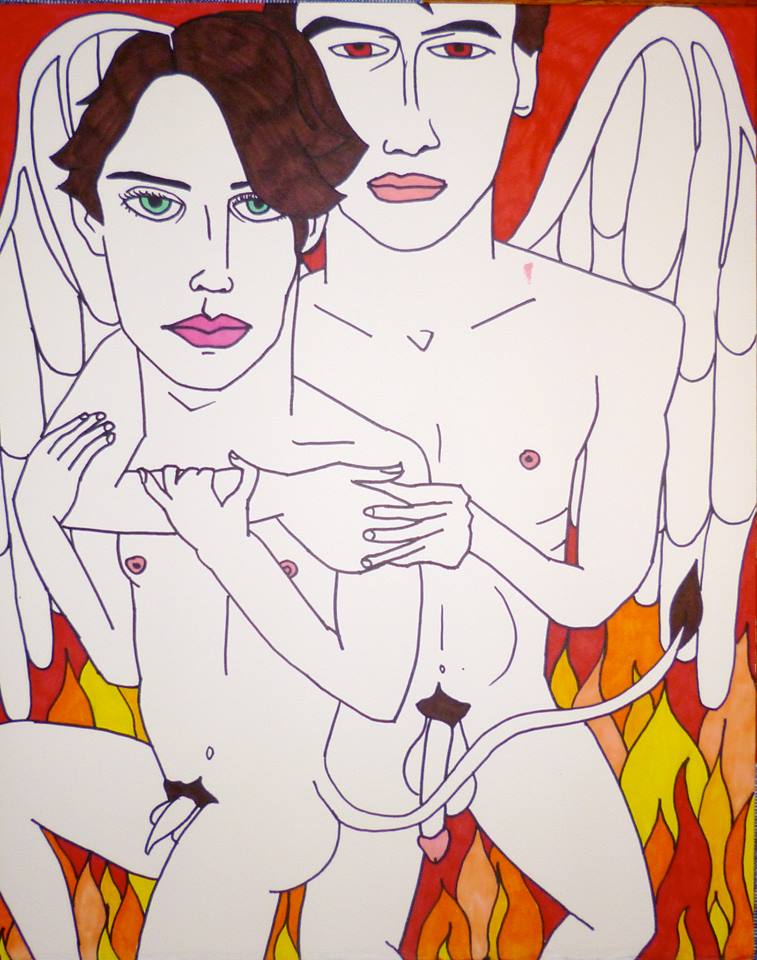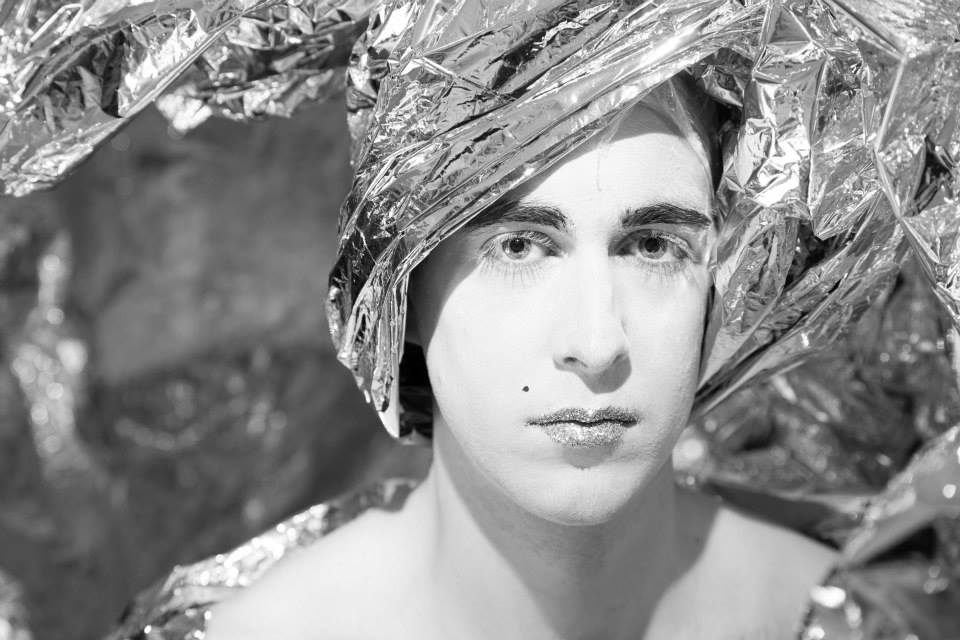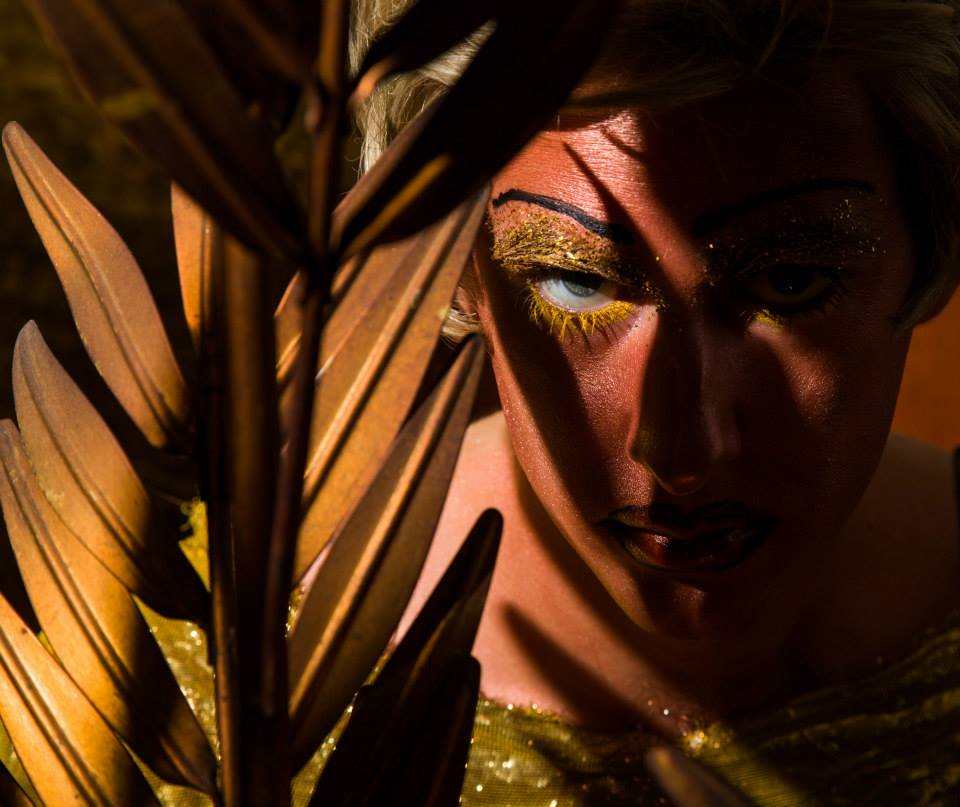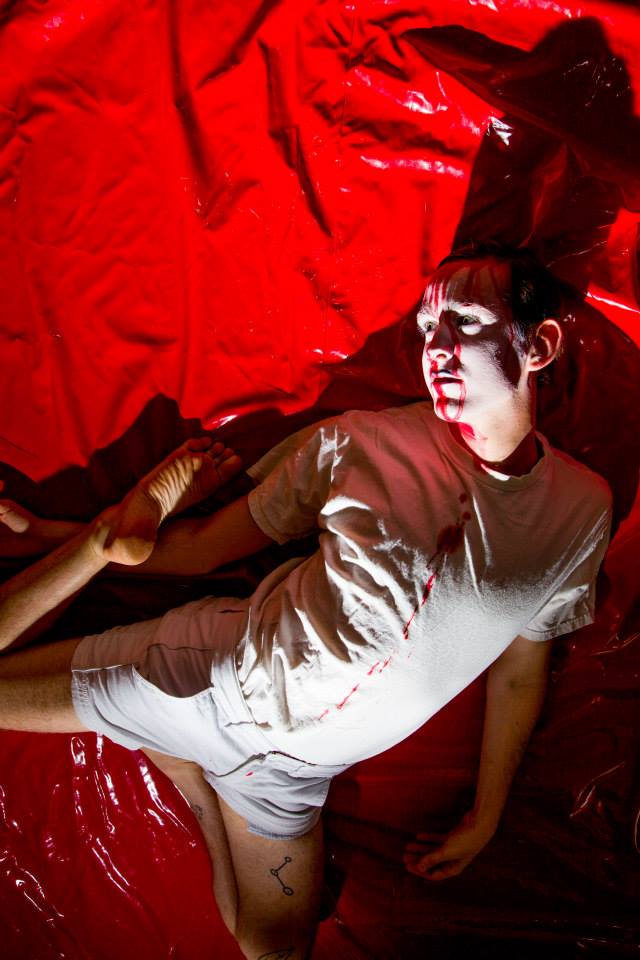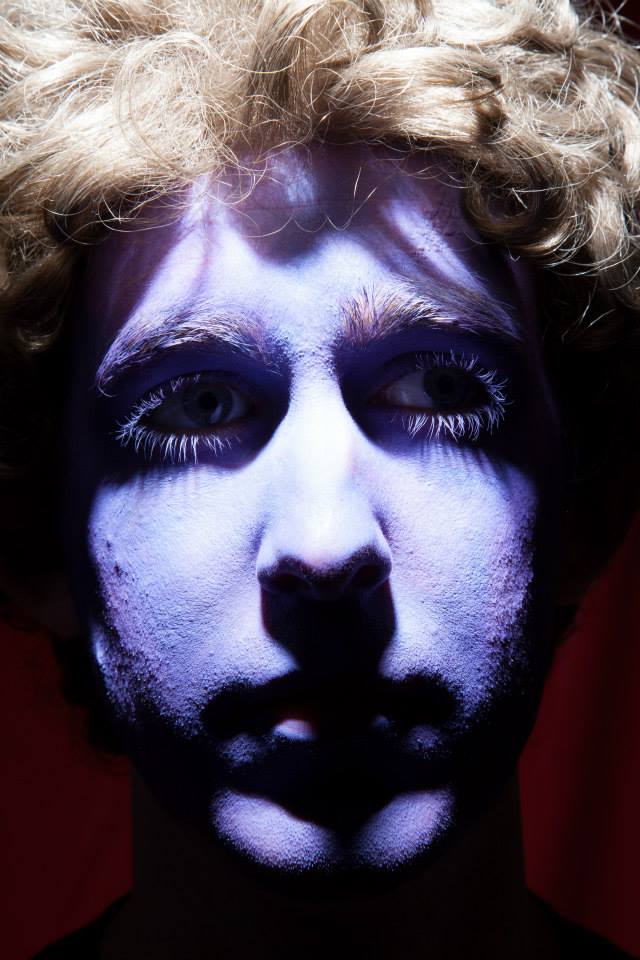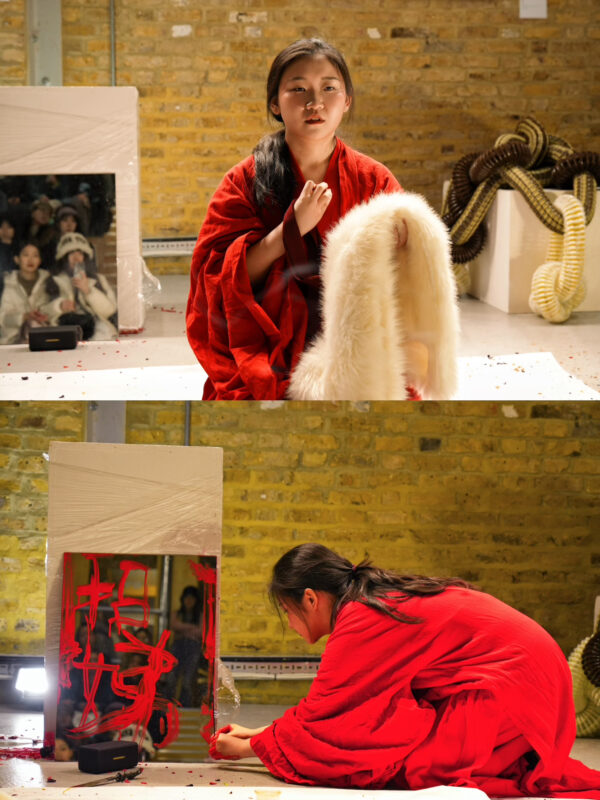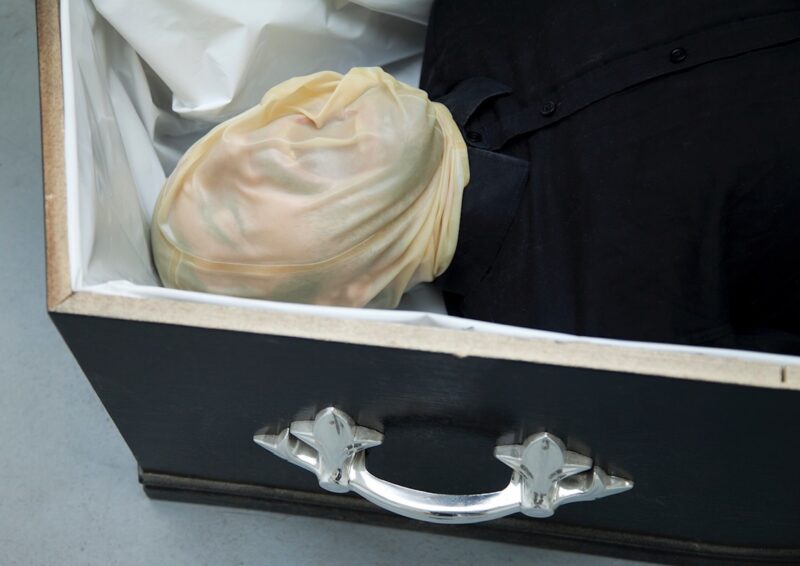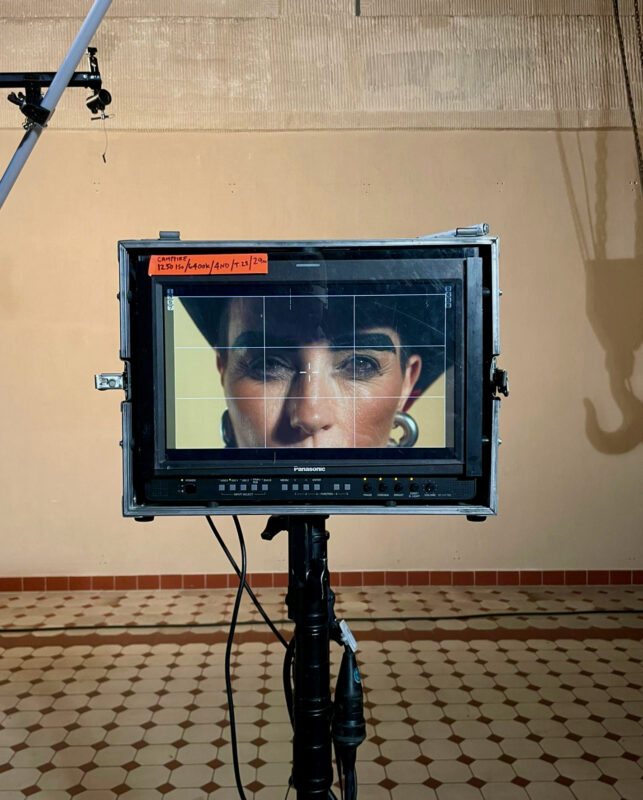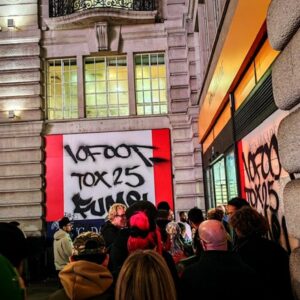Paul Kindersley (b.1985) is an emerging artist based in London. He graduated with a BA in Fine Art from Chelsea College of Art in 2009. Kindersley (also a self-styled make-up enthusiast, stalker, pervert and filmer) works prolifically across media, crossing drawing, film, and performance. His YouTube videos appear as a blurring of various performance histories and styles: camp, drag and clowning included. These videos widely circulated on Twitter offer absurd make-up tips and idiosyncratic social and cultural commentary on anything from Eurovision to Boris Johnson. His famous Makeup Tutorials comically undo (as much as they relish in) ideas about beauty, fandom and celebrity. Social media is the departure point for a number of recent drawings that begin with actual selfies sourced from Twitter or Facebook. These are then transformed into fantastical portraits and scenarios. Kindersley’s performances are filmed or photographed at home and include colour-coded props found around the house. His YouTube monologues are delivered in a deadpan, rambling, off-the-cuff style, that riffs off whatever he happens to be thinking about. His sources, in drawing, film and performance, range from random, immediate thoughts and personal memories, to film, fandom and celebrity culture.
Kindersley is currently exhibiting with Simon Foxall at the Centre for Recent Drawing (C4RD). The C4RD is at 2-4 Highbury Station Road, London N1 1SB. The show runs through to 19 October 2013 www.c4rd.org.uk. Foxall (b.1983) is London-based and represented by Simon Oldfield www.simonoldfield.com. Foxall graduated in 2012 with an MA (Painting) from the Royal College of Art. Work exhibited at the C4RD stage dialogues between drawing and film, from Kindersley’s fascination with celebrity and fandom to Foxall’s finely drawn re-imaginings of film stills, and narratives.
How did you and Simon Foxall come to collaborate on this show at the C4RD? What does drawing mean to you?
I think what we both like about drawing so much is it’s really immediate. You can do it wherever you want, however you want. We both like using pen: from the first line you’re completely committed and you just roll with it. There’s no rubbing out and starting again. That’s the same kind of approach I like with video, and other mediums I work with. I see everything as sketches. I just do it and don’t have time to get really worried about anything. Pen is quite different from pencil drawing. I do sometimes do pencil drawings but I find that when you have the opportunity to go back on something it’s so tempting. When you have a big black marker pen you can’t.
Sometimes I deliberately do the drawings in a way that can be translated onto the body (coloured shapes, for example). I paint myself exactly as the drawing on paper: I paint my face and then put it back into the drawing. I like the idea of swopping between everything. I see all the work as very similar whether it’s video or drawing on paper.
Do you ever self-censor? Do you ever throw drawings away?
I keep most drawings. I find that often I go back to things from years ago. I enjoy doing the things on Facebook and Twitter now. You have to post the drawings immediately whether you like them or not.
On Twitter you just seem to go for it. You’re not afraid of being outrageous. On a social media platform you just never know how you’re going to be received.
I quite enjoy the weird responses I get on Twitter. People are uninhibited whereas coming to a gallery most people (especially if they know you) are very polite and very nice. On Twitter and Facebook you can get people who are really horrible. I really enjoy that (most of the time).
What is so interesting for you about your relationship to social media? It’s very much part of your practice as an artist.
YouTube was the first one. I think what I like about YouTube so much is it’s so immediate and you get your work out there. Everyone goes on YouTube to search for things and I quite like that. I don’t think that many artists use it in that way. Perhaps they think it’s a bit too ubiquitous but that’s what I like about it. I always look at artwork on Vimeo but what you don’t get there is this mad, giant accidental audience (which I like). Especially when I’m referencing lots of things that start their life as films or TV or celebrity. It just feels right to put all that straight back where it came from. I see the YouTube work as sketches. I normally don’t like planning things in advance because I feel then I lose something. When I sit down and do something and am constantly worrying about what I want to say (or what I should say), then I find that I don’t say anything. I prefer having these spontaneous ideas. Either it will start with drawing or painting myself or just drawing. It will turn into something and some works are successful while others are not. I like thinking about YouTube as a sketchbook.
I’m fascinated by this idea of a sketchbook: how you use your body and social media as a sketchbook.
I like having this open sketchbook. But then it does create problems with what’s a finished artwork, and what’s not. And what is the art work: whether it’s just my continuing relationship with things, and my immediate responses to things. When I was hanging the show with Simon (his drawings are very beautiful) I had about 200 drawings and I could have covered every inch of wall space. In a way that would have been quite appropriate for my work.
Your work reminds me of being a child, being in one’s bedroom, and doing stuff like copying and drawing pictures out of magazines or comic books. I like that on your drawings you can see imperfections, the process of colouring in with felt tips. I like the bright, jarring colours.
I love seeing the marks as well. Even though I’m using the Internet the whole time, I do love things where you can see the artist’s hand. I would much rather see the makings of things (like special effects) within the work than see something where everything is perfect and smoothed over. I remember once talking with someone about doing a print. We put it into the printer and it made all the colours into block colours and it just ruined it. It became like some weird graphic. I love the personal interaction with the process of making work. Lots of my work is developed out of a domestic space. I do the work at home. As you say, the child’s bedroom, that’s the sort of thing that I’m interested in, the personal relationship to fandom.
What does this idea of fandom mean to you?
The weird relationship you have to idols or people you admire: whether they are somebody famous, or whether it is somebody you know or you don’t know. With a still image, especially, you can turn somebody into an idol. I think especially on Twitter it is quite a negative thing to be this superfan but I think it’s definitely in human nature. I think it’s something interesting and exciting. I didn’t realise the extent of it especially all the young girl fans. Twitter really opened my eyes to it, this really insane mind-set. It’s fascinating.
You use humour to talk about fandom. You take the piss out of it a lot?
I don’t necessarily mean to take the piss. The work is funny but it all comes from a place of respect and love for these people or things. I get asked to do drawings or YouTube performances of particular people. I find that if I don’t feel some kind of a relationship to (or respect for) the person I’m doing a make-up tutorial about I can’t get into it.
Who makes special requests for drawings and performances?
I get hundreds of requests on YouTube. Sometimes for really odd things. There’s one person who keeps requesting pictures of me showering in white T-shirts. That always makes me want to do things like that.
Why do you refer to yourself as a stalker?
I like to play with words that have negative connotations, and see them in a more exciting way. The idea of a stalker is negative but it also has glamorous connotations associated with film stars. I’m interested in stalker films: the effigies stalker characters put up, the ways they change a room, paint on the walls.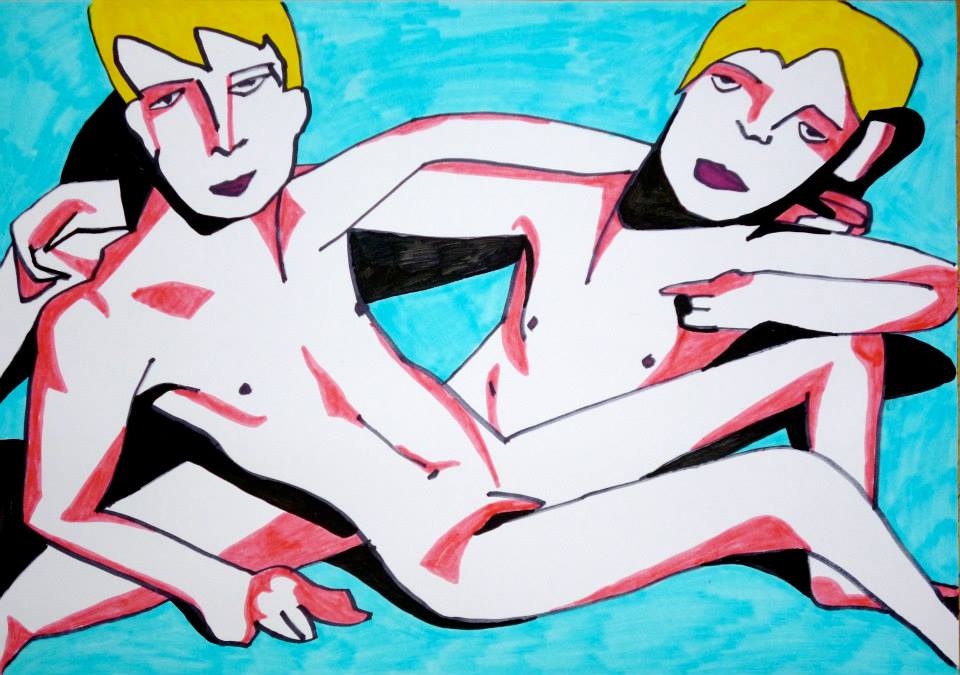
‘Lucky Pierre’ (up at C4RD) and the Jedward drawings relate to fandom and stalking?
‘Lucky Pierrre’ is Pierre Clémenti who had a role in Belle de Jour. He was a really beautiful actor. He worked for everyone famous. I don’t think he was very good at acting but he was really beautiful. Someone on the Internet, a megafan, has taken screen images of every single moment he was ever on screen. So there are thousands of images of him.
I think in Britain we strive for these odd celebrities and create them out of fandom. I love it. I think it’s brilliant. Jedward are so bizarre and incredible so I made a few drawings of them. Because of Twitter, I started getting embroiled in all these mad fans and I just loved that interaction. Then, Jedward themselves banned me for making rude drawings of them. But some of them aren’t that rude. I imagine that all the characters I choose for my drawings can inhabit a space altogether. You have Pierre who’s all broody and good-looking; and then you have these mad blonde twins who are in unison.
What does celebrity mean to you? You’re a bit of a celebrity yourself, in a funny way. You have quite a following on YouTube and Twitter I think.
When I was younger I liked going to the cinema a lot. It seemed like on screen people were completely different and alien. I didn’t have a television until I was 16 so I went to the cinema all the time. The older I got the more I realised that everyone is the same really. With celebrity culture now people are craving to be, or want to be the person on the screen, or the person in the magazine. But of course that person doesn’t really exist because there are so many things that have gone into that process: from make-up, to camera angles to Photoshopping. In fact, most people are much more similar that we think.
Your Twitter portraits send up celebrity culture?
For Twitter I started making images drawn from film stills. I then began to ask people on Twitter for images of their faces. Lots of these images remind me of old film stills, the approach is similar. I absolutely love selfies, the ways that people take these weird voyeuristic pictures of themselves. Or images where they’ve spent ages cropping it; and try to get the look that makes them more sexy and interesting. This is exactly the same as in the ’40s or ’50s when stills or quad posters would be sent out to cinemas to capture the whole film in one look. I start drawing the faces and put them into all these scenarios (scenarios that come from childhood stories and memories, things like Bible stories). I think of all these memories as shared history, and so they became more and more ridiculous and colourful. I like things that give you rules because I don’t really have rules in my artwork. With the Twitter drawings, I draw the face of the first person to reply to my call out, and then I re-post them so that anyone can see them. It gives me a time frame.

The speed at which you do the Twitter portraits is also interesting.
I don’t necessarily know what’s going to happen when I start a drawing. I just say I’m doing a drawing. I think the Twitter drawings function in the same way as the YouTube videos. I think that Twitter and YouTube are very domestic. Everyone uses them at home alone. I love the way that the YouTube videos assimilate into the weird pool of pop culture.
You talk a lot about the space of the home, the bedroom. The domestic space drives your work a lot of the time but you use really public platforms such as YouTube or Twitter.
I think that’s how fandom works a lot of the time. You take something that’s assumed to be really glamorous and separate, and then you bring it directly into your bedroom through a poster or whatever. I like the constructed space of a film meshing with somebody’s personal space or biography. I think for everyone it all gets meshed in the middle. I don’t think that’s a negative thing. You become part of the film and the film becomes part of you. It’s all very connected.
I’m also struck by how the YouTube videos are often in your kitchen. It’s very domestic, very uncontrived. There are all the everyday objects, and the mundane things of everyday life, and then you stage your YouTube videos very deliberately within that space.
I think there’s no use hiding the pen marks. But in a way I think it’s just as glamorous or just as unglamorous as anything else happening. I think everyone is in that world now. Everything is so not real. But I don’t know whether people realise necessarily how not real it all is. When people watch TV they might say: ‘how am I going to get that look?’. Well you’re not going to get that look: it comes from several cameras and lighting and make-up. It’s not real, you’re watching it on television. I love these separations. All my artwork functions in these kinds of spaces.
What’s so interesting to you about make-up?
I don’t really know anything about professional make-up. But since I’ve been doing it I get sent lots of make-up which is really exciting. I think there’s something about painting your face. Everyone’s transforming themselves, adding to their own body, through make-up, the clothes they choose to wear. Make-up became a way of talking about things that happen in the world.
Your body becomes your sketchbook. Do you rehearse the performances that use your body?
No, I think if I rehearsed them then the whole time I’d get worried about remembering what I thought I should do. I like having rules like using the house supplies. If I want everything green, then I have to scour the house for green objects. I might end up with a vase or an apple.
You allow for things like failure, and for things falling off or slipping off, or stumbling when you talk. This is distinctive about the way you work.
Nothing is planned. It works for me. I like immediacy. When I have an idea I like to see it through within the day at least.
Do you see yourself as a painter?
I only paint on myself. Sometimes I think the things I do on my body are very painterly and look like paintings. I paint backdrops for my performances. That’s more about necessity, if I need something there and then, I just make it.
Your sexy drawings, circulated on Twitter, are so outrageous and funny. You play with exaggeration a lot.
I love films especially from the ‘70s, where you get sex and horror together, and everything is so extreme. Plot is disregarded and it’s about showing as many boobs as possible. It gets really ridiculous. I love that energy. Now if you watch sexy films (or pornography which I just hate), most of them are really sterile (horror films too). Clinical and horrible. There was a time when it was much more about pushing boundaries. It was all very exuberant.
How do you think about your sexy images? What do you call them?
They’re grotesque. I like that word in a good way. They’re exaggerations of where people like to stare – places like breasts and lips and cocks. They are these exuberant exaggerations of all that which I think was there in a certain era of film.
The drawings relate back to film. But also art history – work like Beardsley?
Yes, Beardsley as well. I think the drawings all relate back to images that were real discoveries for me such as Beardsley. My parents had copies of The Yellow Book.
Your work is also social commentary on a number of levels.
I think that exploring different sides of who you are is such an important thing. I play a lot with stereotypes and I like them. I find them really fascinating. I do find it very frustrating when people are too afraid to be anything than what is socially prescribed. I enjoy characters and looks that are on the edges.
Paul Kindersley and Simon Foxall are exhibiting at the Centre for Recent Drawing (C4RD) until 19 October. The C4RD is at 2-4 Highbury Station Road, London N1 1SB www.c4rd.org.uk
For more about Paul Kindersley www.paulkindersley.co.uk
Simon Foxall is represented by www.simonoldfield.com
All images courtesy of Paul Kindersley.

